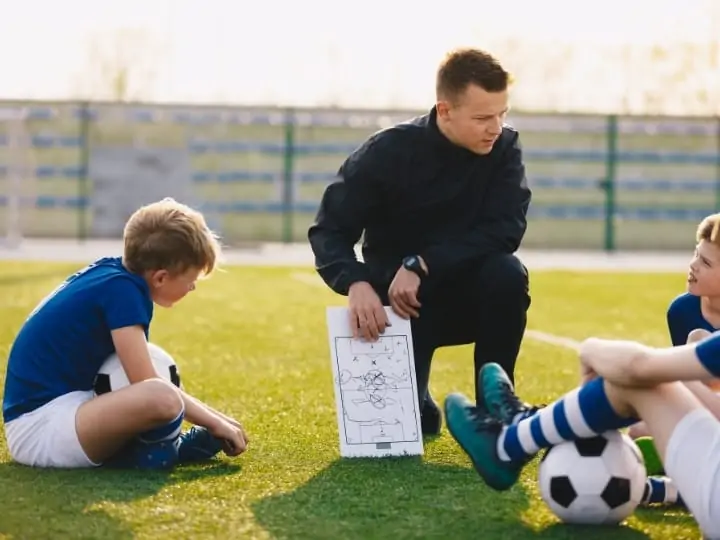Share the post "Cost of Youth Soccer (Running a Soccer Team)"
Youth soccer clubs can be found in every corner of the country, and they can be costly to operate. The sport’s growth, especially at the youth level, has been tremendous. There are an estimated three million youth soccer players in the United States.
There are numerous opportunities for youth players of all skill levels and abilities to participate in the sport. Local clubs are constantly competing with each other to attract the best players and build their names.
However, as these clubs continue to grow, the money they need to compete also grows.

Youth Academy Costs and Funds
Most clubs around the world use an academy system. In an academy, players are able to sign contracts, sometimes at a very young age, that tie them to the club.
Lionel Messi, one of the greatest players of all time, signed for FC Barcelona at age 13. He then worked through the Barcelona academy and broke into their first team. The rest is history.
The youth soccer system here in the United States is vastly different from what we see in other countries.
Our system is largely based on pay-to-play.
Some American professional and semi-professional clubs have a youth academy affiliate, but most clubs are independent.
This means that some families are forced to pay exorbitant amounts of money for their children to be on the best teams.
In any case, youth sports across the globe are a business. There are financial incentives for youth soccer clubs to become bigger and better.
It is not just professional clubs that need to make money. Youth clubs must do the same.

Why do youth soccer clubs need money?
Operating a youth soccer club can get very expensive very quickly. There are a seemingly infinite amount of costs that go into making a soccer club operate. The size of the club will impact its operating costs.
Some of the things that a club need to pay for are:
- Soccer balls
- Kits (jersies, shorts, and socks)
- Goals
- Cones
- Field supplies (flags, line chalk/paint)
- Field rentals
- Referee fees
- League and tournament fees
- Coaches and trainers
- Insurance
As you can imagine, these costs add up pretty quickly.
Most clubs have many, sometimes multiple for each age group, that cost thousands of dollars to keep each one going.
Where does the money come from?
To cover all of the costs, clubs have many outlets from which they can make money.
- Club fees – for most clubs, this is where the largest portion of their money comes from. Players (or their parents) pay fees to the club to help cover the costs.
- Tournaments – one source of income clubs can use to offset their costs is by hosting tournaments. Of course, this comes with a whole new set of costs, but by chagring participation fees to other teams, they can end up earning money.
- Sponsorships – in many communities, local businesses are willing to provide financial support to youth sports to help cover some of their costs. The business typically recevied some brand exposure in return for their money.
- Fundraisers – these are a popular way for youth clubs to earn additional money for the club. Selling candy, club merchandise, or other items to people in the community earns money the can help the club financially.
As clubs require more and more money to continue to operate, they will continue to find other sources of income to take the burden off of families.

Where does the money go?
When it’s all said and done, the club can have money left over at the end of the day. If the club is well-run, it will operate at a profit and not at a deficit.
Any money that is leftover can be used to continue to advance the club. They can make upgrades to their facilities or their gear.
They could afford to spend money on more/better trainers who will improve the club’s ability to produce quality players.
All of these things make the club more attractive to players and their parents.
When a club’s teams get better, they can start charging a premium for their service and bring in more money through their fees.
The differences between the clubs that have a lot of money and the ones that have very little money are easy to see.
Their facilities are very different. Their facilities are usually reflected through on-field success.
Do I have to pay a lot of money to play soccer?
Playing soccer doesn’t have to cost a lot of money. All that is required is a ball and you can become a great player.
You can work on skills alone or with any size group and learn the game. Even using free resources like YouTube, you can learn skills and tactics that will make you a better soccer player.
With that said, it is an unfortunate truth of the American soccer system that it can cost a lot of money.
Many families are priced out of the sport and their children are not given the opportunity to meet their potential as soccer players.
Some of the best clubs in the country can cost thousands of dollars annually, just for the team fees. Most families are on their own when it comes to extra costs that come along with club soccer
- Travel
- Hotel expenses
- Gas
- Plane tickets
- Extra training
- Extra gear
- Soccer shoes
Having the disposable income to pay for all of this can put a financial strain on families that is just not feasible.

Is pay-to-play worth it?
Playing for the best clubs and training can give young players an advantage when it comes to being discovered and advancing to the next levels.
College and professional scouts, when they’re looking for players, are going to watch the elite clubs.
It is possible that a player will be discovered playing on the street or recreationally, but when you’re playing at the highest level, coaches are more likely to find you.
It is completely understandable if you don’t want to invest thousands upon thousands of dollars into your child’s youth soccer career.
If your child has the will and desire to become a great soccer player, you can get better by playing. Not only is that the best way to improve, but it’s also free.
While it might be more difficult to be discovered this way, nothing is impossible. With some willpower, effort, and creativity, you can do it!
Share the post "Cost of Youth Soccer (Running a Soccer Team)"
Joel is a seasoned soccer journalist and analyst with many years of experience in the field. Joel specializes in game analysis, player profiles, transfer news, and has a keen eye for the tactical nuances of the game. He played at various levels in the game and coached teams - he is happy to share his insight with you.



